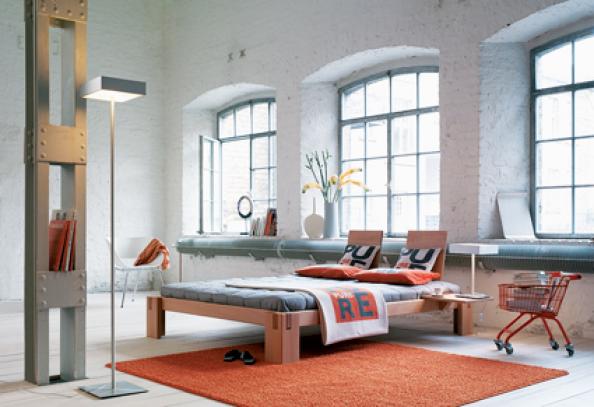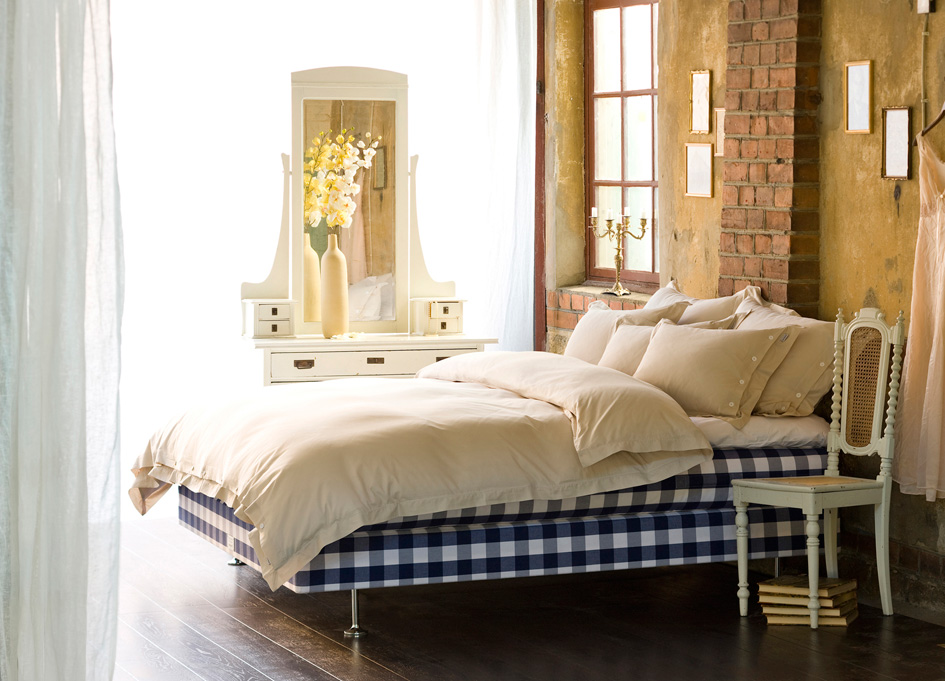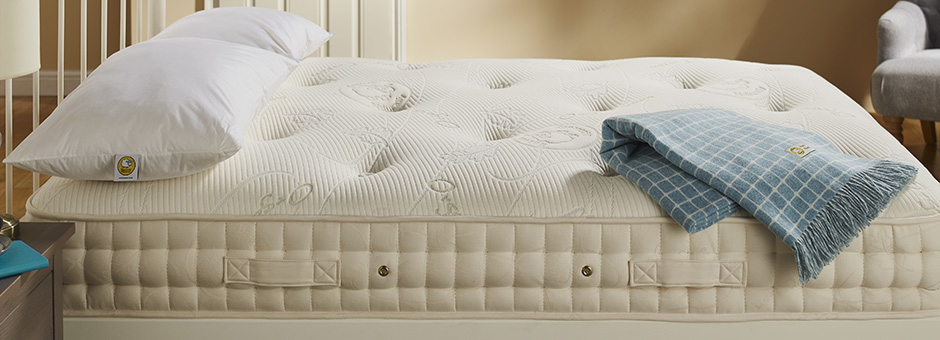Beds for blissful nights - organic, natural, eco-friendly
A good mattress and bed frame is a major investment, so choose one made from quality natural materials that are sustainable, long-lasting, won't off-gas and can be recycled. And watch out for noxious fire retardant chemicals in mattresses...again theses are more usually used on cheaper foam filled mattresses

We all want a comfortable bed - and more of us are wanting to know what materials are used to make beds, preferring eco-friendly, biodegradable ones. If you live in the UK, look for companies that manufacture in Britain and use natural, renewable materials including wool, coir and natural latex, with no FR chemicals or synthetic fibres. As such the mattress will be biodegradable at end of life - i.e after around 15 years' use. *If luxury brands are too expensive new, do check out eBay for Vispring, Savoir Beds, Abaca, Harrison Spinks, Hypnos etc for second-hand mattresses, which have been used seldom and always covered with a mattress protector.
Unless you have small children for decades on end, the odds are that you will spend around a third of your life in bed. Which means it is well worth thinking about the healthiness and eco-friendliness of something you'll be spending so much time on and in.
When around eight hours of your day is spent in bodily contact with a surface, you want to know that surface isn't awash with chemicals that may well off-gas for some considerable period and cause skin irritations.
Mark Dowen is MD at hand-made bed company Cottonsafe Natural Mattress, based in Devon. Producing top quality mattresses and beds using natural, sustainable materials, predominantly wool and organic sheep's wool, Dowen urges people to ask about the use of fire retardant (FR) chemicals in products, even if the product they're interested in is described as 'organic' or 'natural'.
While many mattresses may well contain organic cotton, wool and other natural materials, they are not fully organic or even natural, strictly speaking. He explains that to pass British fire regulations the mattress cover has to be treated with FR chemicals.
‘The only way to pass the regulations is for the cover to be either pure wool – wool being inherently fire retardant – or Cottonsafe®, our patented cotton-feel fabric which uses organic cotton blended with wool. Cotton alone, organic or not, simply will not meet the safety standards required by law unless it's FR treated.
'So I take issue with companies that say they have an organic product when the mattress is in most cases covered in cotton that has been chemically treated. Also, beware of organic latex, because it's classified as a foam under UK fire regs, therefore has to be chemically treated with FRs, whether it’s subsequently covered in wool or not. All FR chemicals are nasty and noxious and they go on off-gassing. A lot of research in the US has confirmed fears that these chemical cocktails are linked to cancer. Interestingly, many FR chemicals have been banned in the US and in the EU yet the UK chooses to keep them in use, despite the very real health risks and harm to the environment they pose.’
Peter Tindall, a director at Devon-based Naturalmat, which hand-makes quality natural mattresses, says the firm avoids chemicals: 'There are many merits to having an organic wool mattress,' he says, 'both for the quality of your own sleep, and for the wider environment.'
And if you're worried about dust mites, Tindall explaining that lavender, eucalyptus and lemon essential oils are used to fortify lambswool used in Naturalmat mattresses against these microscopic bedfellows, while natural wool mean fire-retarding chemicals can be avoided.
Rhiannon Rowley, founder of West Wales-based Abaca Organic, a Soil Assocation Certified organic bedmaker, says she's encouraged by the huge increase in numbers of people contacting the company because they want an organic bed. 'I think the big benefit of an organic mattress is that it's so much healthier because you don't have the chemicals.
'For hundreds of years people slept on natural materials, it's only been over the past 75 or so years that synthetic foams have in - and they are problematic because they're derived from oil and are heavily processed. So for me, I wanted to start a company that went back to the materials of nature. And because we're certified organic at every step of the process, customers can have total confidence in our products - which are extremely comfortable and very long lasting.'
If you want a mattress with no metal in it (ie no pocket springs), Naturalmat offers natural fibre mattresses that contain latex, organic coir, organic lambswool, cashmere and mohair (Cashmere soft kingsize mattress £2,300); while Abaca Organic offers two wool and horsehair only mattresses (prices from £2,043)
Latex - is it the healthiest option?
Real latex is derived from the rubber tree and it's a good material for natural, eco friendly mattresses because it's biodegradable and it's supportive. But Peter Tindall suggests it's a common misconception that latex mattresses are very soft and squidgy. 'Latex is a dense, elastic material that doesn't work like synthetic memory foam! Latex is good if you want a firmer mattress, and it's an excellent, albeit quite expensive, material for sleeping because it's an open cell structure, so is breathable. It's also hypo allergenic and antimicrobial, so is very good for asthma sufferers or people with sensitve skin.'
Naturalmat's latex mattresses are made more supple by alternating layers of latex and layers of organic coir, and you can choose between soft, medium and hard tensions. But Tindall says if sink-in softness is a key requirement for your mattress, you'll probably find a pocket sprung one is preferable. 'But comfort is very subjective, of course, and a mattress that's too soft to one person might feel hard to another. With beds, you really do have to go and try one before you buy.'
Rhiannan Rowley at Abaca Organic urges people to check that any latex mattress is guaranteed as 100 per cent natural latex, because unscrupulous mattress makers are known to combine latex with foam, or synthetic latex, to cut down on costs. She offers 100 per cent latex mattresses which are topped with organic wool for softness - and she says half of the company's sales are now for their latex mattresses.
William Lana at Totnes eco-retailer and manufacturer Green Fibres is positively evangelical about promoting the choice of sustainable materials: 'We started the company in 1996 to offer a natural and organic alternative to the things people were buying that were made from synthetic materials,' he says. 'I was interested in the science behind the fabrics – materials such as polyester are far more energy-intensive to produce than a natural material and they are unlikely to biodegrade, and to be toxic in their creation and in their lifetime through off-gassing.
Mike Meehan, former MD at Plymouth-based handmade bed manufacturer Vi-Spring, is a big fan of wool and horsehair. 'As well as having a reduced impact on the environment, all-natural materials are soft, comfortable and extremely healthy to sleep on. For example, Vi-Spring uses Moosburger European horsetail, obtained from a responsible, family-run business in Austria. Horsehair is the longest natural fibre available, and its intrinsic resilience gives our beds springiness and durability. Wool, also natural and sustainable, is also ideal for use in bed-making thanks to its combination of softness, breathability and bounce. We source our wool from sheep crofted on the remote Shetland Isle.'
Think about how you'll dispose of a bed
Buying a top quality bed will ensure a good night’s sleep for many years, but at some point you will need to replace it. An estimated seven million mattresses end up in landfill in the UK each year and we should be striving to reduce radically that figure.
James Newall, showroom manager of Hastens Fitzrovia in London, says it's easy to take apart a natural fibre mattress and either re-use parts or put them in the ground to biodegrade: 'We use natural materials such as pure flax, hypoallergenic horsehair, wool, cotton and Swedish pine harvested from sustainable forests. All our materials are carefully-sourced biodegradable materials that have minimal impact on the environment during the harvesting, usage and disposal of the product. A product made from nature results in a product that nature happily takes back at the end of its lifecycle.'
Choosing a bed - divan or slatted base wood bedframe?
Divans remain the most popular choice in the UK, and a good divan base can be as complex as a mattress, being a mixture of springs and padding, sometimes with drawers built-in to provide extra storage space. Divans and mattresses are usually sold as a set and deteriorate at the same rate, so they may create more waste than bed frames which last a lifetime, only requiring the mattress to be changed and the occasional new slat.
When considering a divan base you need to ask many of the same questions as for a mattress – what is it made from, how much energy was used in its manufacture and how well will it biodegrade? To improve biodegradability, Abaca, for example, makes bases without any springs, just using materials such as horsehair and wool for springiness. Håstens' beds are handmade in Sweden from sustainable materials such as local pine, wool and horsehair.
With a bed frame check that wood used in it is PEFC/FSC-certified and that it has been finished with natural oils rather than toxic varnishes. Consider reclaimed wood - Eat Sleep Live, and Modish Living, for example, have a wide range of traditional and contemporary bed frames made from reused timber that is hundreds of years old. Both companies manufacture in the UK. For solid wood frames, also see Leicester-based Get Laid Beds.
If you prefer a metal bedframe, these can be bought as restored antiques from companies such as the A Barn Full of Brass Beds or Victorian Brass Bedstead Company (though beware of cheap Chinese “antiques”). While they will not biodegrade like wood, antique bedframes can usually be repaired and resold, while modern metal ones can usually be recycled.
Choosing your mattress
On top of your divan base or bedframe comes the mattress, which as we've seen can be made of any number of different materials, all with their various advantages and disadvantages from an environmental point of view:
Futon – these Japanese mattresses, used on the floor or a slatted wooden frame, are thin enough to fold up and put away, so they are firmer to lie on than a sprung or foam mattress. They are mainly stuffed with materials such as cotton or wool, although synthetic wadding may also be used. Futons last between five and 10 years and will biodegrade if they are filled with natural materials. Green Fibres offers a 6cm futon made from three layers of organic wool, starting from £560, while Cambridge Futons has a deeper futon made from all-natural materials, including lambswool, hemp and coir dipped in natural latex, from £775.
Memory foam – this spin-off from the space race is a temperature-sensitive form of polyurethane foam that has special additives to mould it into shape a few seconds after being exposed to a heat source such as a body. As it is petrochemical-based it will off-gas VOCs and does not biodegrade, although it may begin to lose its springiness in not much more than five years. On the plus side, it creates a warm sleeping environment, and it dust mites aren't keen on it. It may be treated with toxic fire retardant chemicals. So if you're eco, well, memory foam isn't really a goer..
Natural rubber latex – this is a milky substance tapped from the Pará rubber tree (Hevea brasiliensis) which is whipped up with air and turned into a solid foam. The tapping doesn’t damage the trees, which live for around 30 years. Some chemicals are used on the plantations, and sometimes petrochemicals such as turpentine are used in processing of the latex, although these don’t usually end up in the finished products. Around four per cent of people are allergic to natural rubber, although other allergy sufferers will benefit as it is hostile to dust mites and mould growth.
Rubber latex mattresses have a very long lifespan of up to 30 years and are ultimately biodegradable. It’s worth noting thought that many companies, including Dunlopillo, mix some synthetic latex in with the natural rubber to improve longevity. Check if fire retardant chemicals have been used, and also the composition of fabric tickings.
Other latexes – not all that is called latex actually comes from rubber. “Pure Latex” can, for example, legally contain as little as 20 per cent rubber, while “Natural Latex” need contain only 80 per cent rubber. Synthetic latex is created from two oil-derivatives: styrene and butadiene. It will not biodegrade, but is as comfortable as the rubber product while not causing allergies.
Regular foam – foams are created by whipping air into various substances such as polyeurethane to create a cushioning layer. The amount of VOCs from regular foam is minimal, but it does not biodegrade.
Sprung – sprung mattresses contain coils of metal which may be joined together as a mat of springs or with each spring separate in a pocket of fabric. This creates a very bouncy surface, although of course the metal part will not biodegrade. Various fabrics and paddings are used over the springs – consider whether these are natural, organic and biodegradable. Horsehair is commonly used for its resilient springiness, but as this is usually a slaughterhouse by-product, it may concern vegetarians/vegans (coir is a vegetable alternative). Check if potentially toxic fire retardant treatments have been used – more expensive beds using natural wool will probably avoid the need for this.
While a cheap sprung mattress will last no more than 10 years, premium handmade versions can last much longer. Vi-Spring, for example, offers a lifetime guarantee on its mattresses, which contain Shetland Isle and British fleece wool, horsetail, cashmere, mohair, bamboo, cotton and silk along with handcrafted pocket springs (prices from £1,200).
Waterbed – waterbeds have a low use of raw materials in their manufacture - although the vinyl is a petrochemical product - and also leave little behind at the end of their lifespan. They do, however, require constant energy usage to keep the water at a comfortable temperature, around 620kW hours a year. Popular in the '70s..but they are cumbersome and if they were to leak..well, just imagine the mess...
One option is you can't afford a top-of-the-range mattress is to buy a de-luxe topper from a top brand, which can give new life to a mattress that's coming to the end of its days but isn't quite dead in the water. Savoir Beds, for example, has king size toppers starting at £1590 ..ouch...but far cheaper than the mattressess themselves!
All in all, plenty to think about. And it's good to find there are companies that care about how they make their products, and do all they can to ensure their bed frames and mattresses need never end up in landfill.
For more information about links between cancer and FR chemicals, contact the Cancer Prevention Society
or Wake Up Uk












